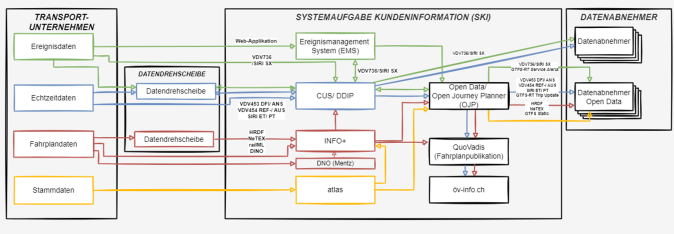Switzerland
Overview in the National Level
In Switzerland the Federal Office of Transportation (FOT) was tasked with the realization of the National Access Point (NAP) for Switzerland, called the “Open data platform mobility Switzerland” (ODMCH). Additionally, a national open non-discriminatory trip planner has been made available named after its interface standard “Open Journey Planner” (OJP-System). A demo is available here.
It is important to note, that the presented data covers primarily conventional public transport of all of Switzerland. The goal is to extend to other forms of transport, too. All street related data is handled by the Federal Roads Office in Switzerland (FEDRO), while all geographical and topological information is gathered by the Federal Office of Topography (swisstopo). Here we focus on the FOT related data.
Via these two channels, Switzerland provides the following data standards for Switzerland:
| Timetables | NeTEx – Swiss Profile |
| On demand | NeTEx |
| Realtime data | SIRI-ET/PT – Swiss Profile |
| Events | SIRI-SX – Swiss Profile |
| Routing | OJP 1.0 – Swiss Profile (Documentation, API)
OJP 2.0 – Swiss Profile (Documentation: Work In Progress, API) |
| Fares | OJP-Fare – Swiss Profile (Documentation, API) |
Use cases
Description
NeTEx is not used by (public) transport operators in Switzerland. The export is primarily used by the neighbouring countries and their larger transport operators (e.g., SNCF in France). The reason being its complexity (you need experts to understand and apply it) and multiplicity (substitution classes and similar constructs make simple adaptations difficult). Data exchange for timetables is mostly done by HRDF:
SIRI-SX is being actively used to represent disruptions, while SIRI-ET and -PT have only recently been introduced and are not widely adapted (currently VDV 454 and 453 are used mainly).
The GTFS standards are used most by small and medium-sized mobility providers.
The OJP standard is being increasingly adapted by transport operators, alongside the use of the routing service. With the recent introduction of OJP 2.0 we expect another increase.
Architecture
The following Figure provides an overview of the public transport data being centrally provided and processed for the various previously introduced data categories.
Short translation:
- Ereignisdaten = event data
- Echtzeitdaten = realtime data
- Fahrplandaten = timetable data
- Stammdaten = master data
- Datendrehscheibe = data exchange hub

Use cases
The provided data is used for all public transport customer information systems in Switzerland.
Furthermore, a set of showcases created with the ODMCH data can be found here:
Outcome
The easier the standards are to use and to adapt, the more they are accepted and used by transport operators and mobility service providers.